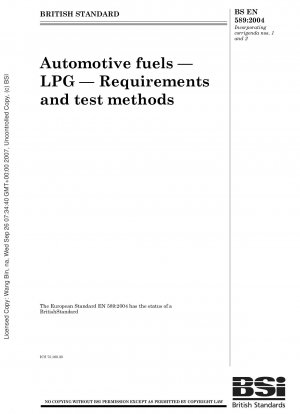BS EN 589:2004
Automotive fuels — LPG — Requirements and test methods
- Standard No.
- BS EN 589:2004
- Release Date
- 2004
- Published By
- British Standards Institution (BSI)
- Status
- 2008-11
- Replace By
- BS EN 589:2008
- BS EN 589:2008+A1:2012
- Latest
- BS EN 589:2024
- Scope
- This European Standard specifies requirements and test methods for marketed and delivered automotive LPG (Liquefied Petroleum Gas). It is applicable to automotive LPG for use in LPG engine vehicles designed to run on automotive LPG.
NOTE: For the purposes of this European Standard, the term"% (V/V)" is used to represent the volume fraction.
WARNING - Attention is drawn to the risk of fire and explosion when handling LPG and to the hazard to health which arises through inhalation of excessive amounts of LPG.
LPG is a highly volatile hydrocarbon liquid which is normally stored under pressure. If the pressure is released large volumes of gas will be produced which form flammable mixtures with air over the range of approximately 2 % (V/V) to 10 % (V/V). This European Standard involves the sampling, handling and testing of LPG. All procedures should be conducted away from sources of ignition such as naked flames, unprotected electrical equipment and electrostatic hazards. Testing should be performed as far as practicable under an electrically-safe ventilation hood.
LPG in the liquid form can cause cold bums to the skin. Protective clothing such as gloves and goggles should be worn if contact with the skin is likely to occur.
Unnecessary inhalation of LPG vapour should be avoided. The operator should not be exposed to atmospheres containing more than 1 800 mg/m
over an 8 h time-weighted average (TWA) reference period, or more than 2 250 mg/m over a short term, 10 min reference period. One of the tests described in this European Standard involves the operator inhaling a mixture of air and LPG vapour. Particular attention is drawn to the cautionary statement provided in A.1, where this method is referred to.
BS EN 589:2004 history
- 2024 BS EN 589:2024 Automotive fuels. LPG. Requirements and test methods
- 2022 BS EN 589:2018+A1:2022 Automotive fuels. LPG. Requirements and test methods
- 2018 BS EN 589:2018 Automotive fuels. LPG. Requirements and test methods
- 2008 BS EN 589:2008+A1:2012 Automotive fuels. LPG. Requirements and test methods
- 2008 BS EN 589:2008 Automotive fuels - LPG - Requirements and test methods
- 2004 BS EN 589:2004 Automotive fuels — LPG — Requirements and test methods
